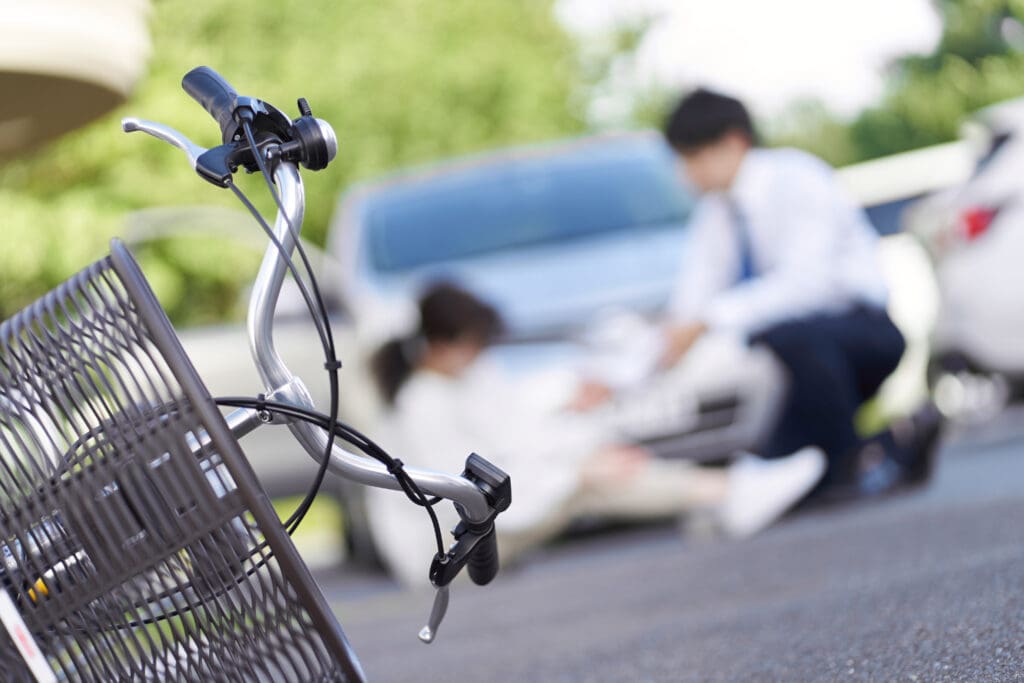Who is at Fault For a Right Hook Bicycle Accident?
When you suffer serious injuries in a right-hook bicycle accident, the last thing on your mind is a personal injury lawsuit. Your focus is (and should be) on your recovery. The problem is, your recovery from the bike crash can cause serious financial strain on you and your family. Few people are financially prepared for unexpected medical bills. Paired with lost time at work, the bicycle accident can leave the victim in an enormous amount of financial debt. Filing a personal injury claim against the at-fault individual will help you recover damages for your losses.
Munley Law’s bicycle accident attorneys can help you understand your legal options and fight for the compensation you need to recover. We offer a free consultation to new clients and will guide you throughout the claims process. Call today to get started.
What is a Right Hook Bicycle Accident?

A right-hook bicycle accident is where a vehicle makes a right turn and collides with a cyclist traveling in the same direction. These collisions typically happen at intersections when drivers fail to check blind spots or misjudge a cyclist’s speed before turning. They’re particularly dangerous because the turning vehicle cuts directly into the cyclist’s path, leaving little time to react. Cyclists often get caught between the vehicle and the curb with nowhere to escape. Injuries from these collisions tend to be severe and include broken bones, head trauma, road rash, and sometimes spinal cord injuries or internal damage.
Determining Fault in Right Hook Accidents
The first step in any case is to determine who is at fault for the accident and then hold them responsible for their negligent action. To prove fault in a bicycle accident claim, a Munley personal injury attorney will break down the four components of negligence in your case:
- Duty of care: According to Pennsylvania law, a bicycle is a legal vehicle, entitled to the same rights and responsibilities as a car. Motor vehicle drivers must exercise reasonable care toward bicyclists. That means drivers must check their mirrors to make sure the bike lane is free before making a right-hand turn. They should use their signals when making a turn to alert other drivers, cyclists, and pedestrians. Drivers must not be distracted, fatigued, aggressive, reckless, or intoxicated when behind the wheel.
- Breach of duty: A breach of duty occurs when the motor vehicle driver fails to exercise reasonable care when sharing the road with cyclists. If the driver fails to check the bike lane before making a right-hand turn and hits the cyclist, their negligence is a breach of duty of care. The injured cyclist has the right to file a claim against the driver.
- Causation: The personal injury attorney must prove that the bicyclist’s injuries are a direct result of the driver’s negligence.
- Damages: Finally, your personal injury lawyer will decide what damages you should pursue in your case. The injured cyclist may collect compensation for medical expenses, lost wages, property damage, and pain and suffering.
Evidence Needed to Prove Fault in a Bicycle Accident
There is no such thing as collecting too much evidence. The Munley law firm will dedicate a substantial amount of time to building a strong case with an abundance of documentation. While the insurance company will conduct its own investigation of the accident, Munley’s personal injury attorneys will conduct an independent investigation of where the right-hook accident occurred.
We will use eyewitness testimony for unbiased evidence in your case. Our lawyers will consult with an accident reconstruction expert who will investigate skid marks, debris, and turn video surveillance footage. We will obtain cell phone records, police reports, and conduct interviews with drivers and bicyclists to establish the basis for compensation claims.
Preventing Right Hook Accidents: Driver and Cyclist Responsibilities
Not all accidents can be stopped. However, both drivers and cyclists can take steps to minimize risk when traveling.
Motor Vehicle Drivers
- Use turn signals well in advance before making a turn to alert cyclists in the bicycle lane.
- Check mirrors and blind spots.
- Yield to cyclists in the bike lane or on the shoulder of the road.
- Make turns at an appropriate speed that allows for a safe reaction time.
- Be aware of the “Dutch Reach’ method — opening car doors with your right hand when parked, which naturally turns your body to check for approaching cyclists.
- Avoid passing a cyclist just before making a right turn, as this creates the perfect conditions for a right-hook bicycle accident.
Cyclists
- Maintain high visibility with reflective clothing, lights, and other equipment to improve your chances of being seen, particularly at night.
- Stay in the proper lane position. Sometimes, taking the full lane when approaching an intersection can prevent right-hook scenarios by making yourself more visible and preventing cars from passing and then turning into your path.
- Be constantly aware of intersections. Watch for vehicles that may turn right and for those with large blind spots.
- Make eye contact with the drivers when possible.
- Use proper hand signals for turns and stops.
Compensation Available for Right Hook Bike Accident Victims
As we briefly mentioned, a bicycle accident victim has the right to recover compensation if the crash was caused by a negligent driver. There are two main forms of damages that an injured cyclist can collect in a personal injury claim: economic and non-economic damages.
Economic damages include:
- Current and future expenses (emergency care, hospital stays, surgeries, physical therapy, and anticipated future medical expenses for ongoing care).
- Lost wages (to cover income lost during recovery and diminished earning capacity if injuries result in permanent limitations affecting job performance).
- Property damage (to cover the costs of damaged bicycles, equipment, and personal items).
Non-economic damages may include:
- Pain and suffering, which encompasses physical discomfort and emotional distress beyond financial costs.
- Rehabilitation costs (which may include specialized services, psychological counseling, home modifications, and assistive devices for those with permanent disabilities).
Don’t settle for less than you deserve. Let Munley Law’s bicycle accident attorneys calculate the full value of your claim and fight for maximum compensation.
Steps to Take After a Bicycle Accident
Taking the right steps in the moments, days, and weeks following a right hook bicycle accident can ensure your safety and help protect your rights in a personal injury claim. Here’s what you should do:
- Seek immediate medical attention, even if injuries seem minor. Many serious conditions may not present obvious symptoms immediately.
- Document the accident scene with photographs that show the positions of the vehicles, traffic signals, and road conditions. Collect the driver’s contact and insurance information.
- Report the accident to the authorities to ensure an official record exists. Request a copy of the police report for your records and insurance claim.
- Be careful when speaking with insurance adjusters. Provide only basic facts about the accident without speculation. Decline to give recorded statements or sign medical authorizations without legal guidance.
- Pennsylvania has a two-year statute of limitations for filing personal injury lawsuits, but building a strong case requires early evidence collection and documentation.
Contact Munley Law right away for guidance on protecting your legal rights and building a strong claim. Our experienced bicycle accident attorneys can assist you throughout the legal process, allowing you to focus on your physical recovery while we seek compensation.

Marion Munley
Marion Munley is recognized for her compassionate representation of catastrophically injured clients and her steadfast dedication to them and their families. Her advocacy has produced numerous multimillion-dollar recoveries, including one of the largest trucking accident settlements on record. Marion is Triple Board Certified by the National Board of Trial Advocacy in Civil Trial, Civil Practice, and Truck Law, and since 2023 has been named one of Pennsylvania’s Top 10 Super Lawyers by Super Lawyers.
Posted in Personal Injury.









